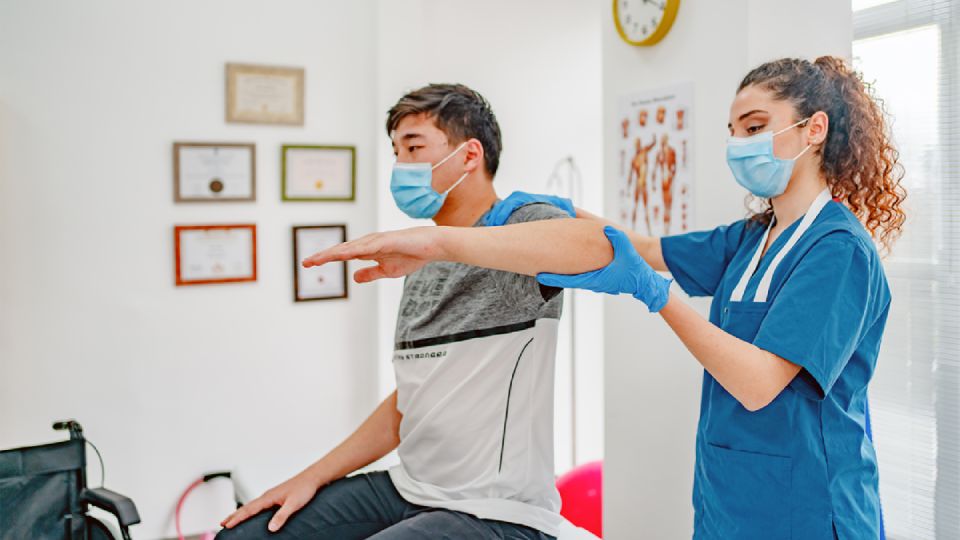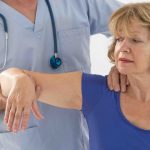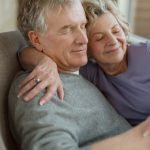Stroke is a medical condition characterized by the sudden cessation of blood circulation in one or more areas of the brain. There are two classifications of stroke: ischemic stroke (caused by narrowing, partial or complete blockage of an artery) and hemorrhagic stroke (caused by trauma or rupture of a blood vessel).
Ischemia causes the cessation of blood circulation in blood vessels of the brain, leading to the death of the soft parts of the brain. The degree of tissue damage depends on the duration of oxygen starvation and the overall subject’s health. The degree and nature of brain damage also determine the structure and duration of physical rehabilitation program after a stroke.
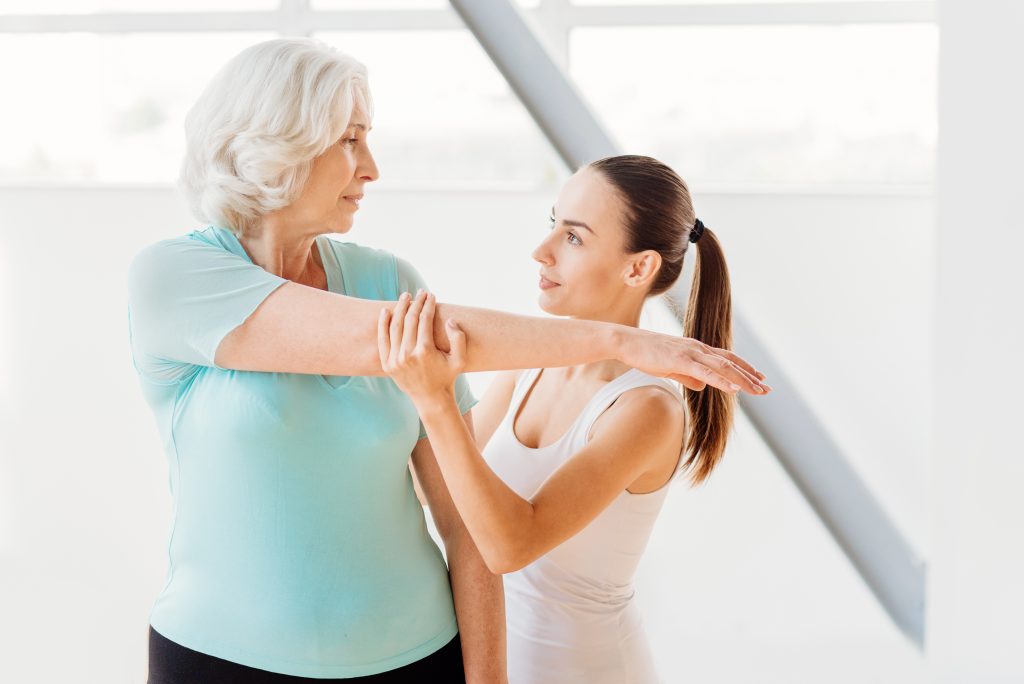
Benefits of stroke recovery exercises for physical and mental health
It has been proven that exercises to restore walking and other motor activities within the framework of stroke rehabilitation have multiple positive effects, such as restoring self-care and independent mobility, normalizing psychological and emotional health, and restoring cognitive functions.
Rehabilitation of elderly people after a stroke has both physical and psychological benefits.
Physical benefits:
- regeneration of strength;
- improved endurance values;
- improved walking speed;
- improved balance;
- increased ability to perform daily activities;
- reduced risk of recurrent stroke.
Psychological benefits:
- mood improvement;
- improved brain function;
- stress relief;
- improvement of personal self-esteem and self-confidence, which may be lost after a stroke;
- motivational development.
Factors influencing recovery time after a stroke
Factors influencing recovery time after a stroke:
- Stroke classification: ischemic or hemorrhagic. Ischemic stroke is the most common type of stroke, caused by a lack of blood supply to a part of the brain and accounting for 80% of cases. With timely and appropriate medical treatment, rehabilitation programs, and their implementation, the chances of recovery are very high. Hemorrhagic stroke is caused by bleeding in part of the brain. In this case, the chances of death can reach 70%.
- Extent of brain damage. The greater the brain tissue damage, the lower the chances of full recovery after a stroke – with or without physical exercise. Some parts of the brain may never recover, and recovery may take years.
- Age and concomitant diseases. The older the person, the more difficult it is to overcome a stroke. The situation is complicated if there are chronic concomitant diseases. If there are cardiovascular diseases, recovery may be impossible.
- Previous strokes. Recurrent strokes increase the likelihood of death. Recovery after the first stroke can take up to six months, but subsequent strokes can prolong this period. Full recovery cannot be guaranteed, and it may take years.
- Mental and emotional condition of a person. Recovery requires strong determination, motivation, and desire to get well. Not all patients can cope emotionally with what has happened.
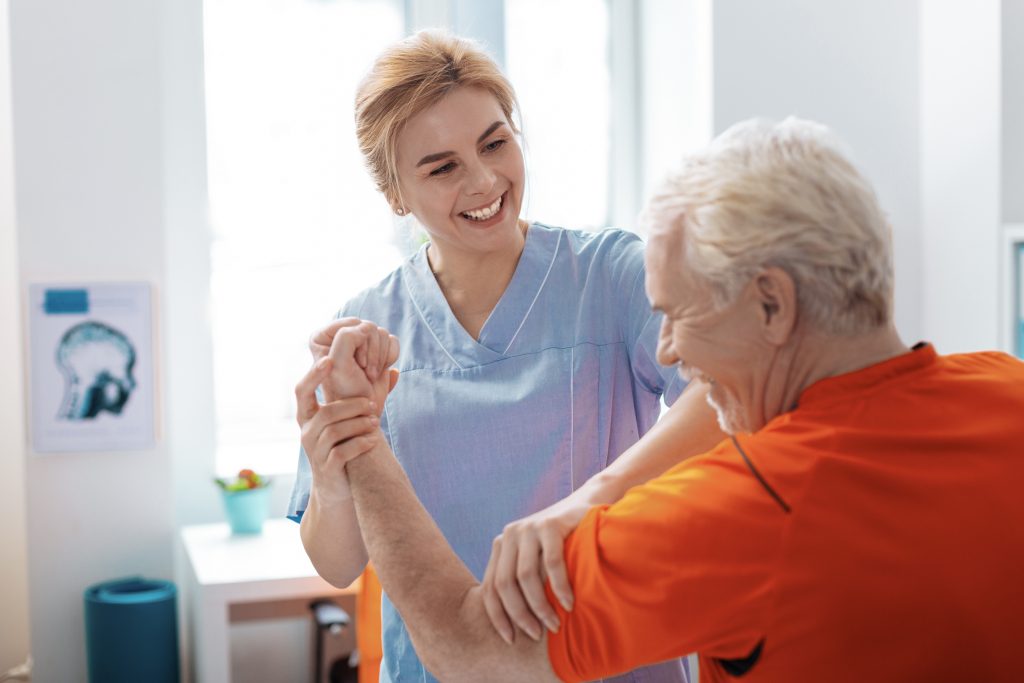
Stroke rehabilitation begins immediately
It is a mistake to think that a stroke should be “treated” and hospitalized first, and recovery should begin a little later. Stroke rehabilitation and exercise are treatments, and they should be started as soon as the condition stabilizes. This means that pulse and blood pressure are stable, consciousness is clear or improved, body temperature is not elevated, etc.
The compensatory capabilities of the human body are so high that it is essential to activate them as soon as possible. You can watch videos for correct exercise execution – https://ghrs-group.ru/rehab/illness/reabilitatsiya/nevrologiya/insult.
How to support a loved one
If your relative or close friend is recovering from a stroke, think about how you will support them before they leave the hospital. It has been proven that a positive atmosphere and family support contribute to the patient’s recovery.
Beds should also be conveniently located, and medications should be available to meet all the patient’s needs.
Self-recovery
Even in uncomplicated cases, it is impossible to recover on your own. In the beginning, you will always need the help of others. In the hospital, doctors and nurses provide this help, and after being discharged, relatives and friends take over.
During this period, a person should focus on dismissing negative thoughts and concentrate on recovery. It is also important not to forget to regularly take medications prescribed by the doctor.
Stages of recovery after a stroke
There are three main stages of medical care after a stroke:
- Acute phase. Lasts up to three weeks. During this period, doctors try to save a patient’s life and restore blood flow to the brain using medications and other treatment methods. The patient is hospitalized to recover basic life functions.
- Early recovery phase. Begins when the life-threatening stage has passed. Depending on the patient’s condition, a stroke rehabilitation plan is developed by specialists at a rehabilitation center. The patient receives treatment aimed at restoring basic self-care functions. This period can last up to six months. At this stage, therapeutic massage, moderate physical exercises, physiotherapy, and manual therapy are usually added to the rehabilitation program.
- Final stage of stroke rehabilitation – exercise. After six months, when the patient’s condition stabilizes, the doctor adjusts the post-stroke rehabilitation program and adds new treatment methods. The goal is to help the patient return to normal life as quickly as possible. The final stage of rehabilitation also takes up to six months. The best option for patients is to undergo this recovery stage in a medical center. Here, specialized massage therapists and therapists help patients regain their motor skills. If there are speech disorders, a speech therapist works with the patient. It is equally important for a psychologist to support the stroke patient during the recovery period.
The loss of vital functions often leads to negative thoughts, apathy, and depression. Psychologists and psychotherapists can help restore the will to live and the desire to heal. This is very important for recovery after a stroke! People themselves must want to defeat the disease!
In the late stages of recovery, patients need support, patience, and care. The involvement and assistance of relatives in post-stroke recovery at home affect the patient’s comfort, faster adaptation to a new life, and self-confidence.
Video: “Rehabilitation after a stroke”
A set of exercises for rehabilitation of post-stroke patients. Set No1 is aimed at improving the functions associated with mobility in bed.
For additional information about the rehabilitation after a stroke you can watch a video demonstrating exercises and rehabilitation recommendations.
Passive and active rehabilitation after a stroke
Initially, patients undergo training indoors under the supervision of a physiotherapist instructor. The patient performs simple movements with his arms and legs with the help of the instructor. This is called passive rehabilitation. In passive rehabilitation of the upper and lower limbs, the instructor works on large joints first and gradually moves to smaller ones. Rehabilitation therapy and recovery after a stroke start with the shoulder and hip joints. After training the thigh, the instructor helps the patient flex and extend the shin, then the knee joint, then the ankle joint, and finally, the doctor trains the leg joint.
Rehabilitation includes massage from the feet to the lower back. Arm rehabilitation begins with exercises for the shoulder joint, followed by exercises for flexion and rotation of the elbow and wrist joints. The upper limbs are massaged from the fingers to the shoulders. The combination of exercises and massage stimulates brain function. When partial motor function recovery is achieved, physiotherapy exercises become more intense, and the patient performs them independently. The duration increases from 10 to 30 minutes, and active rehabilitation begins.
With significant brain damage, paralysis, and decreased sensitivity, rehabilitation is conducted using medications, massage, electromagnetic stimulation of nerve cells, acupuncture, and reflexotherapy. After the recovery of some motor functions, the rehabilitation therapist implements a program that includes exercises.
Exercises for the arms
For the affected arm, bend and extend the fingers in a comfortable position for 10 repetitions.
To strengthen the shoulder joint, the exercise is performed lying on the healthy side. The practitioner stabilizes the shoulder joint with one hand, and with the other hand slowly and smoothly moves the affected limb away from the body. The elbow and forearm are held in a lying position, and the hand is extended; the hand is raised, pulled to the side, and then returned.
If the paralyzed arm hardly moves, the affected limb is lifted and lowered with the help of a holding device and the healthy arm.
Exercises for the legs
To restore mobility in the joints and muscles of the legs, the following exercises are used:
- Hip abduction and adduction.
- Hip rotation.
- Passive flexion and extension of the knee joint.
- Lying on the side with passive flexion and extension of the thigh at the knee.
- Leg lifts with the help of healthy arms and cable pulls.
- Passive ankle movement.
Alternative exercises on the paralyzed limb, starting with the healthy limb and combining with massage and muscle relaxation.
Active movements should be performed slowly and without painful exercises.
Why is it important to have an examination before starting exercises
Before starting daily physiotherapy and motor rehabilitation after a stroke, a patient should undergo an examination. The purpose of the examination is to avoid excessive body stress and to determine which organs and systems require attention during rehabilitation, and if there are any contraindications to physiotherapy.
In most cases after a stroke, motor function is impaired. It is important to prepare the muscles for complex exercises before performing them. For this, the help of a massage therapist is needed. The exercises should take no more than one hour; you can practice twice a day – in the morning and in the evening. The first session should be performed in the presence of a doctor. The doctor will monitor the intensity and duration of each exercise, and keep track of your pulse and heart rate. If your recovery is going well, you can perform the exercises independently at home, but you should follow the doctor’s recommendations.
Which specialists are involved in the rehabilitation process in the hospital?
The multidisciplinary team working with post-stroke patients usually consists of neurologists, physicians, therapeutic movement instructors, speech therapists and linguists, physiotherapists, nurses, psychotherapists, and medical psychologists. In some clinics, the team also includes occupational therapists, who help with mastering daily living skills (using a spoon or a TV remote control, opening a door with a key).
Neurologists identify stroke risk factors and correct them with medications, but physical rehabilitation (strengthening balance, improving mobility) is necessary to recover lost functions. The physiotherapist evaluates the degree of function loss and determines what rehabilitation the patient needs. The physiotherapist will also prescribe additional physiotherapy, such as massage, to reduce muscle tension and pain. Patients with speech disorders (dysarthria, aphasia) or difficulty swallowing as a result of a stroke require speech therapy.
It is important for the patient to be able to adapt to their circumstances and be prepared to work on recovery. However, strokes often lead to depression. This is a significant problem, and psychologists and psychotherapists can help patients overcome it.
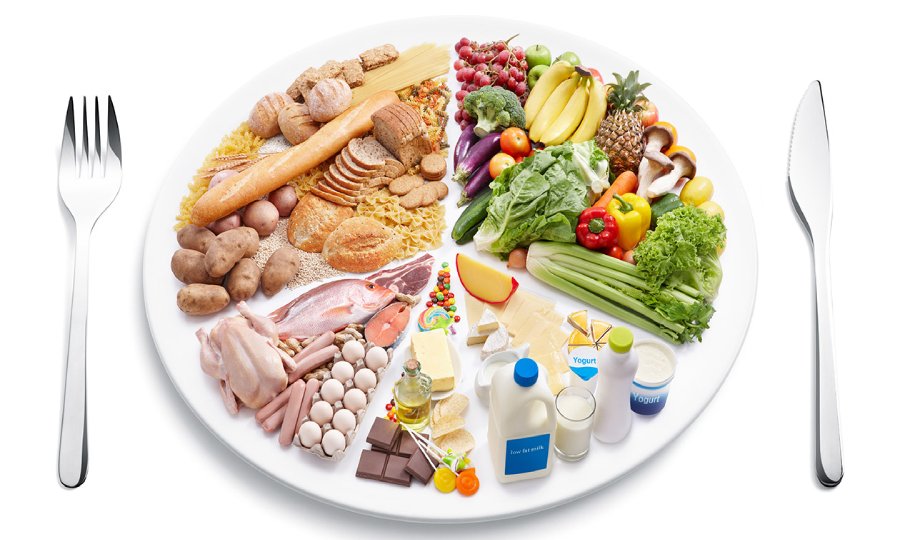
Proper nutrition
If the patient has had an ischemic stroke, home rehabilitation also requires a change in diet. After a stroke, food should be as simple as possible, as there may still be difficulties with swallowing and chewing. In some cases, nasogastric feeding may be performed.
There is a risk of aspiration (food entering the airways), which can lead to suffocation and pneumonia.
If the patient cannot eat independently, they should be fed with a teaspoon, propped up with a pillow, or given food slowly to ensure they swallow.
The main feeding recommendations are given by the doctor on an individual basis. The diet is usually based on the following principles:
- Replace animal fats with plant-based fats,
- Consume up to 150 grams of lean meat and fish daily;
- Increase the consumption of cottage cheese and dairy products;
- Limit the consumption of white bread, pastries, and baked goods;
- Include vegetable soups, bread, porridge, vegetables, and fruits (up to 400 grams) in your diet;
- Limit salt intake.
Drink up to 2 liters of water per day unless there are restrictions due to heart or kidney problems. Note that some patients have diabetes and need a special diet recommended by an endocrinologist.
Beneficially for the cause
Therapeutic physical culture is relatively simple, but these exercises may seem difficult for patients who, after a stroke, have to learn from scratch how to grow new cells.
In order for physical exercises to be beneficial and lead to faster recovery, certain rules should be followed.
Follow the doctor’s recommendations. Only a doctor can prescribe the correct exercises depending on which part of the brain is affected. Only a doctor can tell you which exercises you can perform during the recovery period.
Do not overdo it. Exercises are therapeutic and should not be exhausting or strenuous. Start with light exercises, gradually increase the number of complexes and introduce new, more complex exercises. The goal of the exercises is not to strengthen muscles but to make new brain cells work in the right direction.
Warming up the skin. This is especially relevant for bedridden patients leading a sedentary lifestyle. During this period, the family should help them perform the first exercises. For this, at least some massage is needed. Hands and legs should be stroked and massaged in the direction from the fingers to the knees and from the fingers to the shoulders. All this is done to warm up the skin and enhance blood flow.
Monitor the patient’s mood. Many people after a stroke feel depressed, “overwhelmed,” or do not want to exercise. Insist gently but persistently that everything is done correctly, always praise the recovering and acknowledge his achievements.
Do not forget about consistency. Therapeutic exercises should be performed daily for 40-60 minutes once a day. At the initial stage, this should be done twice, then three times a day.
Be patient. Time is the best medicine. And in this case, this statement is 100% true. After all, it is enough to practice daily for several weeks to see positive results.
Check out the demo version of our workouts for rehabilitation of post-stroke patients on YouTube.
You can find more information about Stroke in our Library of Articles.
Our website presents sets of exercises for the rehabilitation of post-stroke patients in the following areas:
A SET OF EXERCISES FOR REHABILITATION OF POST-STROKE PATIENTS. SET №1 IS AIMED AT IMPROVING THE FUNCTIONS ASSOCIATED WITH MOBILITY IN BED
EXERCISES FOR REHABILITATION OF POST-STROKE PATIENTS. SET №2 IS AIMED AT IMPROVING THE MOBILITY AND STABILIZATION OF THE PELVIC COMPLEX
A SET OF EXERCISES FOR REHABILITATION OF POST-STROKE PATIENTS. SET №3 IS AIMED AT IMPROVING THE MOBILITY AND FUNCTION OF THE UPPER LIMB, STABILIZING THE SHOULDER GIRDLE
A SET OF EXERCISES FOR REHABILITATION OF POST-STROKE PATIENTS. SET №4 IS AIMED AT IMPROVING THE MOBILITY AND FUNCTION OF THE LOWER LIMB, STABILIZING THE PELVIC GIRDLE
You may also find useful information and sets of exercises in the section APHASIA AND DYSARTHRIA, where 5 sets of exercises for rehabilitation for speech disorders are currently presented.

